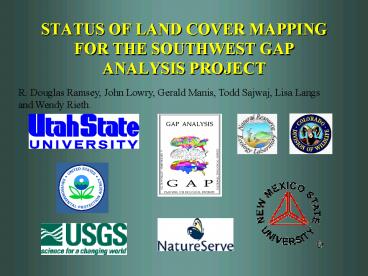STATUS OF LAND COVER MAPPING FOR THE SOUTHWEST GAP ANALYSIS PROJECT - PowerPoint PPT Presentation
1 / 25
Title: STATUS OF LAND COVER MAPPING FOR THE SOUTHWEST GAP ANALYSIS PROJECT
1
STATUS OF LAND COVER MAPPING FOR THE SOUTHWEST
GAP ANALYSIS PROJECT
R. Douglas Ramsey, John Lowry, Gerald Manis, Todd
Sajwaj, Lisa Langs and Wendy Rieth.
2
Objectives
The Southwest Regional Gap Analysis Project
(SWReGAP) is a coordinated effort to complete a
Gap Analysis for the 5 states of Arizona,
Colorado, New Mexico, Nevada and Utah.
One of the key products from this effort and the
focus of this talk will be a seamless map of
natural and semi-natural land cover modeled from
Landsat 7 imagery and ancillary data.
3
SWReGAP Land Cover Timeline
- 2000 Work began
- 2001 Field data collection imagery acquisition
- 2002 Field data collection, imagery acquisition,
classification/mapping began - 2003 Field data collection, classification/mappin
g - continues
- 2004 Accuracy assessment final products
complete
4
Study Area
The 5-state region covers approximately 560,000
square miles. SWReGAP follows the state-based
business model by dividing responsibilities and
funding among individual state teams.
Regional laboratories have been established to
provide direction and develop protocols that are
to be followed by cooperating states
5
Mapping Zones
As an alternative to state boundaries, mapping
responsibilities are distributed along ecological
and physiographic boundaries. The 5-state region
has been divided into 73 ecologically meaningful
mapping zones and grouped into five regions of
state responsibility.
6
Imagery
Landsat 7- 1999-2001 Spring, Summer Fall
Imagery
7
Terrain and radiometrically corrected ETM imagery
for spring, summer, and fall covering the San
Rafael Mapping Zone
8
Data Layers
9
Topographic Relative Moisture Index (TRMI)
Parker, A. J. 1982. The topographic relative
moisture index An approach to soil-moisture
assessment in mountain terrain. Physical
Geography. 3 160-168.
10
(No Transcript)
11
Landform
12
Field Data Collection
ArcView Extension
Field data is collected by someone trained in
vegetation identification and field survey
methods.
A minimum of two digital photos are taken of each
site
A digital form is used to enter field data into
an MS-Access database. A paper version of this
form is used to collect field data.
13
Distribution of 39,834 Sample Points as of July,
2002
1,252 13,420
3,054
1,521 1,300
Collaborator Points
2,184 6,500
3,668 6,935
14
Mapping Zone Field Effort and Mapping Priority
15
Mapping Legend
The goal of the mapping legend was to meet the
defined NVCS Alliance level standard developed by
The Nature Conservancy and NatureServe. We had an
a-priori understanding that complete Alliance
level mapping was not feasible given time,
resources, data availability, and data
capability. Some level of Alliance grouping
into logical and mappable sets would be required.
- An estimated 500 NVCS Alliances have been
defined for the SWGap area - An estimated 100 Ecological System (ES) types are
being generated for the SWGap area by NatureServe - An estimated 60 Alliances (A) are targeted for
mapping across the study area - We estimate that the final mapping legend will
consist of 160 ES/A types for the entire SWGap
area
16
Rule-Based Mapping
- Capitalizes on availability of multiple spatial
datasets - Distinct vegetation communities associated with
different ranges of environmental and spectral
gradients - Example
- CONDITION Elev. gt 2000 AND SprNDVI gt 0.55 AND
SprNDVI lt 0.90 AND landform 6 THEN Douglas Fir
17
ZONALINTERSECT.AML
18
Rule Generation with CART
- Classification and Regression Trees (CART)
- Exploratory tools to identify complex
interactions amongst numerous variables - Single dependent variable multiple independent
variables
19
CART Example Splits on Two Variables
20
CART Example Two Variable Decision Tree
21
Preliminary NLCD classification of the
Wasatch/Uinta Mountains, Utah using decision tree
derived rules from Forest Service FIA plots
N 3,037 FIA Plots
N 1,754 FIA Plots
N 1,852 FIA Plots
22
Preliminary ResultsSan Rafael Swell Mapping
Zone, Utah
Interpretive Model
CART Model
- 24 ES/A Classes
- All pixel mapping
- 16 ES/A Classes
- Data Gaps
23
Detailed Results of CART vs. Interpretive Methods
- Shows more spatial detail
- Fewer classes identified
- Identifies data gaps
- Shows less spatial detail
- More classes identified
- Tends to preclude identification of data gaps
24
Accuracy AssessmentComparison Between Manual and
CART Techniques
Manual Classification
CART Classification
Mapped Manually but not compared
Not Mapped by CART
ASAH BBSA DCSR IRAG MBSB
25
SUMMARY
- Mapping legend will consist of grouped and
individual alliance level land cover types.
Groupings will be defined as Ecological Systems
by NatureServe in close collaboration with
SWReGAP investigators. - CART models provide an excellent method to
identify data gaps and to better understand
biophysical relationships between cover types and
their environments. - Rule based land cover modeling will rely computer
aided regression trees to provide rules and
guidelines for rule development. - It may not be feasible given time and resource
constraints to fully utilize a CART rule
generation system for the entire region.































